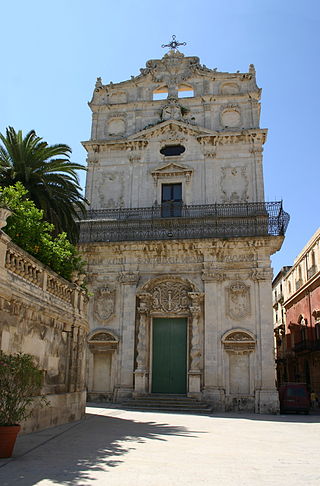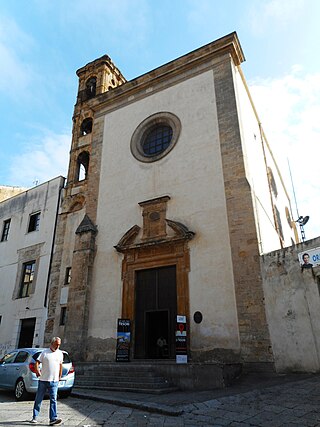
Noto is a city and comune in the Province of Syracuse, Sicily, Italy. It is 32 kilometres (20 mi) southwest of the city of Syracuse at the foot of the Iblean Mountains. It lends its name to the surrounding area Val di Noto. In 2002 Noto and its church were declared a UNESCO World Heritage Site.

Novodevichy Convent, also known as Bogoroditse-Smolensky Monastery, is probably the best-known cloister of Moscow. Its name, sometimes translated as the New Maidens' Monastery, was devised to differ from the Old Maidens' Monastery within the Moscow Kremlin. Unlike other Moscow cloisters, it has remained virtually intact since the 17th century. In 2004, it was proclaimed a UNESCO World Heritage Site.

Val di Noto is a historical and geographical area encompassing the south-eastern third of Sicily; it is dominated by the limestone Hyblaean plateau. Historically, it was one of the three valli of Sicily.

Penne is an Italian town in the province of Pescara, in the Abruzzo region, in mid-southern Italy. According to the last census in 2014 the population was 12,451. It is one of I Borghi più belli d'Italia.

Paola is an Italian comune of 15,408 inhabitants in the province of Cosenza in Calabria.

San Salvatore is a former monastery in Brescia, Lombardy, northern Italy, now turned into a museum. The monastic complex is famous for the diversity of its architecture which includes Roman remains and significant pre-Romanesque, Romanesque and Renaissance buildings.

San Benedetto is a late-Baroque architecture, Roman Catholic church and former Benedictine monastery in the city Catania, Sicily, southern Italy. The church facade faces Via Crociferi, parallels across via San Benedetto the former-Jesuit church of San Francesco Borgia, and both are about a block south along Crociferi from the church and convent of San Giuliano. Entrance to church and monastery appear to be through Piazza Asmundo #9 near the apse of the church.
Monasteries in Spain have a rich artistic and cultural tradition, and serve as testament to Spain's religious history and political-military history, from the Visigothic Period to the Middle Ages. The monasteries played an important role in the recruitment conducted by Christian aristocracy during and after the progress of the Reconquista, with the consequent decline in the Muslim south of the peninsula.

The Minor Basilica of Santi Vicenzo e Caterina de' Ricci is a Catholic church, built in the 16th to 18th centuries, and located in the town of Prato, in Tuscany, Italy. Adjacent to the church is a 16th-century monastery.
San Carlo is a Baroque style, Roman Catholic church and monastery, located in Piacenza, Italy. The church was dedicated to San Carlo Borromeo.

The Monastery of San Nicolò l'Arena in Catania, Sicily is a former Benedictine monastery, located on Piazza Dante 30 in the city of Catania, region of Sicily, Italy. After the Mafra, this abbey is the second largest Benedictine monastery in Europe. It is now a UNESCO World Heritage Site, and houses the Department of Humanities of the University of Catania.
San Niccolò is a Roman Catholic church located on Via Pompeiana 25 in the town of Osimo, in the province of Ancona, region of Marche, Italy.
The Monastery of San Giuseppe is a Roman Catholic cloistered female convent located in Via Regina Margherita #8 at the town limits of Mogliano, province of Macerata, in the region of Marche, Italy.

The Convento de la Madre de Dios is a Dominican convent located in the city of Toledo. It was founded at the end of the 15th century as a nunnery by Leonor and María de Silva, daughters of the Count of Cifuentes. It was a cloistered monastery, a Guardia Civil barracks, and finally a university campus after its acquisition by the University of Castilla-La Mancha to expand the facilities of the Faculty of Juridical and Social Sciences.

Santa Lucia is a Baroque-style, former-Roman Catholic church and the adjacent convent is located on Vicolo Santa Lucia #8 in the medieval center of the city of Rieti, region of Lazio, Italy. The church now mainly celebrates Roman Orthodox rites. The convent in 2020 houses the archaeologic collections of the Museo Civici of Rieti.

Santa Lucia alla Badia is a baroque-style, Roman Catholic church, now deconsecrated, located on the south corner of the piazza duomo, located to the south of the facade of the Cathedral of Syracuse), located in the island of Ortigia, the historic city center of Siracusa in Sicily, Italy. The church building and adjacent former monastery is now used for special exhibitions and functions.

Santa Chiara all'Albergaria refers to a church and former monastery located in piazza Santa Chiara, in the quarter of Albergaria in the city of Palermo, region of Sicily, Italy. The church is located near the busy outdoor Ballarò marketplace.

San Giovanni dell'Origlione is a Baroque-style,deconsecrated, Roman Catholic church located on Piazza Origlione, at the intersection of via Saladino and via Santissimo Salvatore in the ancient quarter of Albergaria of the city of Palermo, region of Sicily, Italy. It was once attached to a convent of cloistered Benedictine nuns, but after years of abandon, is presently undergoing restoration.

The monastery of Santa Maria Teodote, also known as Santa Maria della Pusterla, was one of the oldest and most important female monasteries in Pavia, Lombardy, now Italy. Founded in the seventh century, it stood in the place where the diocesan seminary is located and was suppressed in the eighteenth century.















